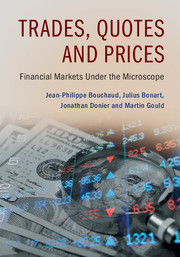Book contents
- Frontmatter
- Dedication
- Contents
- Preface
- Acknowledgements
- PART I HOW AND WHY DO PRICES MOVE?
- PART II LIMIT ORDER BOOKS: INTRODUCTION
- PART III LIMIT ORDER BOOKS: MODELS
- PART IV CLUSTERING AND CORRELATIONS
- PART V PRICE IMPACT
- PART VI MARKET DYNAMICS AT THE MICRO-SCALE
- PART VII ADVERSE SELECTION AND LIQUIDITY PROVISION
- PART VIII MARKET DYNAMICS AT THE MESO-SCALE
- PART IX PRACTICAL CONSEQUENCES
- Appendix
- Index
PART V - PRICE IMPACT
Published online by Cambridge University Press: 26 February 2018
- Frontmatter
- Dedication
- Contents
- Preface
- Acknowledgements
- PART I HOW AND WHY DO PRICES MOVE?
- PART II LIMIT ORDER BOOKS: INTRODUCTION
- PART III LIMIT ORDER BOOKS: MODELS
- PART IV CLUSTERING AND CORRELATIONS
- PART V PRICE IMPACT
- PART VI MARKET DYNAMICS AT THE MICRO-SCALE
- PART VII ADVERSE SELECTION AND LIQUIDITY PROVISION
- PART VIII MARKET DYNAMICS AT THE MESO-SCALE
- PART IX PRACTICAL CONSEQUENCES
- Appendix
- Index
Summary
Introduction
In this part, we jump into the core topic of this book: understanding price dynamics. More specifically, we will consider the important question of how order flows interact to form a price. In particular, how can the predictable order flow elicited in the previous chapter produce unpredictable prices? This question will be our core motivation throughout the remainder of the book.
As ever, we start with two fundamentals: concepts and data. We begin by zooming out and asking questions about how market participants’ actions impact prices, and, more broadly, the state of the market.We are immediately faced with a difficulty: since history cannot be replayed, how can we know how an action really affected the market? Put another way, how can we know that what we observed was not going to happen anyway? This conundrum leads us to the necessity of decomposing impact into two components: the reaction impact, which describes how an action directly affects future prices, and the prediction impact, which describes what would have happened anyway, even in the absence of the action. The sum of reaction impact and prediction impact will correspond to the observed impact, as measurable by an outside observer.
Because it does not require any information about the circumstances in which trades occurred, observed impact often seems to be a natural quantity of study for an outside observer who only has access to public data. However, upon deeper reflection, observed impact reveals itself to be rather non-trivial. On the one hand, some aspects behave as we would expect. For example, buy market orders push the price up on average, sell market orders push the price down on average, and observed impact first increases rapidly before reaching a stable plateau. On the other hand, other aspects are much more surprising. One prominent example is that impact scales as a concave function of order size, such that the seemingly natural idea that this relationship should be linear actually breaks down.
In the quest for reliable measurements of impact, private data is a prerequisite. By allowing a deconvolution of the prediction impact at the scale of the metaorder – and thus getting rid of most spurious conditioning effects – private data offers a reliable way to estimate how order flow dynamically affects the market.
- Type
- Chapter
- Information
- Trades, Quotes and PricesFinancial Markets Under the Microscope, pp. 205 - 207Publisher: Cambridge University PressPrint publication year: 2018



